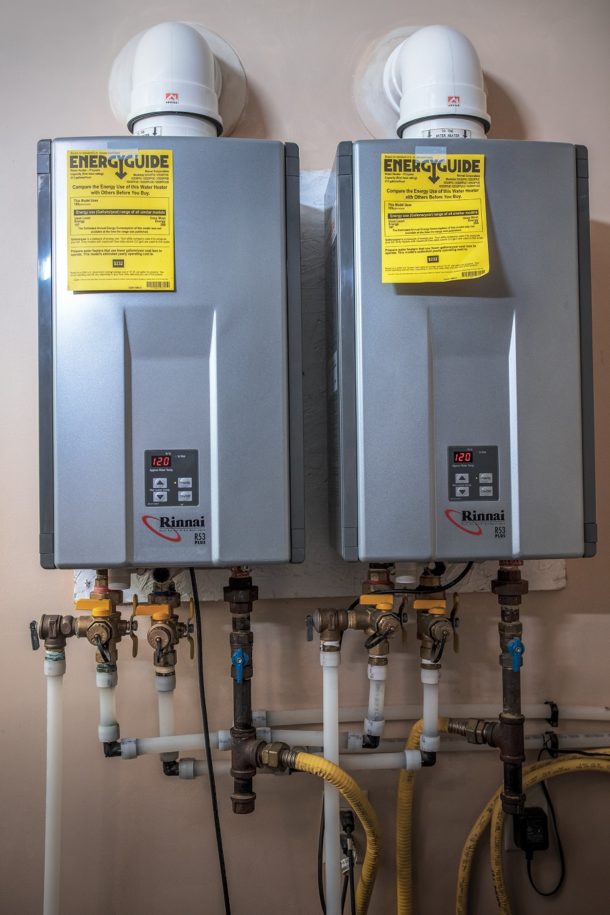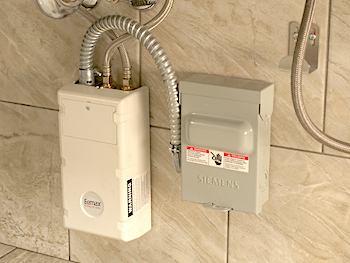Creating opportunities for Rinnai PROs to maximize sales in their local market with an affordable and easy advertising solution Introducing a highly original and innovative advertising offering, Rinnai America Corporation launches the Rinnai PRO 360 Ad Packages. Developed for Rinnai PROs, the advertising package presents a simple, fast and affordable option to engage customers in a 90-day, multi-media campaign. With packages taking as Read more
tankless water heater
Creating opportunities for Rinnai PROs to maximize sales in their local market with an affordable and easy advertising solution
 Introducing a highly original and innovative advertising offering, Rinnai America Corporation launches the Rinnai PRO 360 Ad Packages. Developed for Rinnai PROs, the advertising package presents a simple, fast and affordable option to engage customers in a 90-day, multi-media campaign. With packages taking as little as fifteen minutes to complete and affordable options starting as low as $2,100, PROs can save valuable time and money when advertising their business.
Introducing a highly original and innovative advertising offering, Rinnai America Corporation launches the Rinnai PRO 360 Ad Packages. Developed for Rinnai PROs, the advertising package presents a simple, fast and affordable option to engage customers in a 90-day, multi-media campaign. With packages taking as little as fifteen minutes to complete and affordable options starting as low as $2,100, PROs can save valuable time and money when advertising their business.
“We’re always investing in innovation and exploring new products and technologies that we can bring to market,” said Peter Reiner, Vice President of Marketing, Rinnai America Corporation. “Adding these PRO 360 Ad Packages is a great step towards supporting our PROs and supplying an affordable, easy solution, so they can focus on providing excellent service to their customers.”
With the unique PRO 360 Ad Packages, Rinnai PROs can easily market their services across email, social media, Google and direct mail through prebuilt campaigns, making advertising easy, fast and affordable. Rather than having to create the campaigns themselves or work through an external partner, PROs can simply select from two options: Digital Only Campaign or a Digital + Direct Mail Campaign. With this structure, Rinnai has created an uncomplicated way to deploy a templatized marketing campaign that engages a PRO’s specific market or audience.
“Our PROs are very busy and have a lot of competition for their time. With PRO 360 Ad Packages, PROs can set it and forget it,” said Lori Page, Senior Marketing Manager, Rinnai America Corporation. “This is something new and completely different for the industry, and we’re excited to provide a simple but impactful way for PROs to grow their Rinnai business.”
PRO 360 ad templates are designed to educate the consumer on the benefits of Rinnai products while providing a PRO’s customized promotional offer. Rinnai will launch the program with two pre-built ad templates to choose from, Tankless Water Heater and Home Heating. The PRO 360 Ad Packages will continue to evolve and expand over time, providing PROs with new and exciting ways to engage with their customers.
Rinnai launched its PRO Network more than a year ago with the aim to provide contractors the necessary support and training needed to help grow their business. Now, Rinnai partners with over 3,200 PROs across North America, helping them successfully scale and support their businesses. Participants in the PRO Network experience myriad of benefits, including the ability to grow their business through qualified leads, rebate programs, free training and earning free rewards. Adding the PRO 360 packages is just another reason why It’s Better In Network.
To learn more about Rinnai PRO 360 Advertising, visit www.rinnai.us.
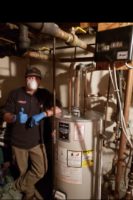
The right residential water heater solution depends on multiple factors Tankless water heaters are one of the most talked-about topics in the home services industry. The rising popularity of tankless water heater technology is being driven by the perception that tankless heaters provide the same dependable performance as traditional tank-type units while using less energy Read more
The right residential water heater solution depends on multiple factors
Tankless water heaters are one of the most talked-about topics in the home services industry. The rising popularity of tankless water heater technology is being driven by the perception that tankless heaters provide the same dependable performance as traditional tank-type units while using less energy and taking up less space.
That is true for certain single-family residential applications. The efficiency and reliability of tankless technology is sufficient to meet many household needs. As long as homeowners do their homework, have a clear understanding of their hot water usage, and work with a professional to select and install the right equipment, there are usually very few issues.
In many circumstances, however, traditional tank-type water heaters still offer maximum performance, reliability and value, and remain a solid option to meet the hot water needs of most families. Both tankless and tank-type applications can be an appropriate solution, depending on a number of factors, including the size of a home, its existing water heater configuration, the demand for hot water, budget, fuel type availability and personal preference.
For a typical residential application — a single-family home with two bathrooms, standard shower heads, a dishwasher and washing machine — one tankless unit will usually be sufficient. But homeowners can run into issues with high-flow, high-demand luxury fixtures, like a car wash shower head or a 90-gallon soaking tub. People may find that their new tankless product works fine 99% of the time, but they can’t get sufficient water pressure out of their high-flow shower head. This is because the flow rate of the fixture exceeds the amount that the unit can produce. Additionally, remodeling or adding to a home with an existing tankless water heater might create more demand than the installed unit can supply.
In those situations, a tankless water heater paired with a storage tank might be the only available option. But this approach is rarely a preferred solution, because most homeowners choose tankless in the first place because they wanted its efficiency or space-saving features.
Tank-type water heaters maintain a constant reservoir of hot water. Tankless heaters only work when a fixture opens, using less energy overall. But tankless requires more energy when it is used, making the transition from tank to tankless a challenge in many circumstances.
Most gas tankless water heaters provide between 120,000 and 199,000 BTUs, compared to about 40,000 BTUs for tank-type residential gas heaters. In order to switch from a gas tank-type heater to tankless gas, the capacity of the gas line may need to be increased, adding complexity and cost to installation. Similarly, an electric tankless water heater can use double or triple the power of an electric storage tank heater, requiring major electrical upgrades.
Venting is another potential roadblock in transitioning from tank to tankless. Adding or expanding the capacity of existing exhaust and intake pipes may be required, which could mean cutting additional holes in the walls and roof.
Maintenance is critical for the longevity and performance of tankless water heaters. Unfortunately, water heaters tend to be the forgotten appliance. They’re hidden behind a utility door or inside a closet, and many people don’t think about them until there’s an issue and they don’t have hot water.
We know many people don’t keep up with the recommended maintenance of their water heaters, but tank-type units can last for 10 years or more with few problems. Tankless water heaters, however, are more likely to show reduced performance and suffer breakdowns if users don’t follow a regular maintenance schedule.
As the popularity of tankless water heaters continues, new features are becoming available, such as recirculation, connectivity and built-in buffer tanks. The Bradford White Infiniti® K Series tankless gas water heaters offer top connections, which make switching from a storage tank heater more convenient. At the same time, innovations like electric heat pump water heaters and condensing gas water heaters are opening new possibilities for energy efficiency in tank-type water heaters.
In the end, the distinction between tankless and tank-type water heaters isn’t as neat as it is often presented. Both technologies offer advantages, and tank-type water heaters will continue to be a solution in many circumstances for years to come. It’s about choosing the right product for the job at hand. As long as consumers know what they’re looking for and work with a professional, they can be confident that they’ll find the right configuration for their home.
 GUEST AUTHOR: Trevor Pinto is the Product Manager of Residential Products and Application Support for Bradford White Corporation and has been with the company since 2012. Pinto began his career in the Product Management Department starting out as a Product Analyst and has grown in the ranks over the past several years. In his current role, he oversees the residential product line as well as the application support team. The application support team is responsible for assisting Bradford White’s customer base with selecting the appropriate product for a specific application and providing general product knowledge.
GUEST AUTHOR: Trevor Pinto is the Product Manager of Residential Products and Application Support for Bradford White Corporation and has been with the company since 2012. Pinto began his career in the Product Management Department starting out as a Product Analyst and has grown in the ranks over the past several years. In his current role, he oversees the residential product line as well as the application support team. The application support team is responsible for assisting Bradford White’s customer base with selecting the appropriate product for a specific application and providing general product knowledge.
Prior to joining Bradford White, Trevor graduated from Indiana University of Pennsylvania with a bachelor’s degree in Criminology. He grew up in the Philadelphia suburbs and is a passionate Philadelphia sports fan, enjoys music and the outdoors including camping, hiking, and fishing. He currently resides in Lansdale, PA with his wife and two children.
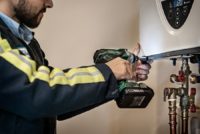
Use these tips to keep customers comfortable this winter Do you know how to ensure your tankless water heater installations perform optimally this winter? Tankless water heaters — known for their on-demand hot water, low energy use, and compact size — are popular among homeowners. Propane-powered systems offer an additional advantage: they can be installed Read more
Use these tips to keep customers comfortable this winter
Do you know how to ensure your tankless water heater installations perform optimally this winter?
Tankless water heaters — known for their on-demand hot water, low energy use, and compact size — are popular among homeowners. Propane-powered systems offer an additional advantage: they can be installed virtually anywhere.
For customers located in regions that experience snow and frigid temperatures, there are a few considerations for HVAC professionals to keep in mind to ensure their customers’ comfort year-round.
Here are eight tips for specifying, installing, and maintaining tankless systems in cold climates:
- Size the unit for the cold. As temperatures drop, more time and energy are needed to heat water to the desired level. To ensure customers’ tanks meet demand throughout the year, it’s important to know how they’ll perform in cold weather. For example, in Washington D.C., a unit that can produce 8.5 GPM on a hot summer day will only produce 5 to 6 GPM on a cold winter day.
- Design for the coldest conditions. Be aware of how low ground temperatures can go and how much water a household will need. Also consider the difference between the set unit temperature and the ground temperature, also known as the Delta T. The bigger the gap, the lower the unit’s flow rate will be.
- Bring it inside. Many tankless systems have some degree of built-in freeze protection. Check the product specs, and your region’s historical weather patterns, to determine where to install the tank.
- Vent smart. Proper venting is important. Installations should avoid freezing winds and have sufficiently long vent runs. In cold areas, the minimum vent run recommendation is six feet.
- Keep vents clear of snow. Before a snowstorm, remind customers to keep a few feet around the vent clear of snow. Some tankless models offer air intake from the outer pipe — if that’s blocked, the unit may turn itself off.
- Educate customers with recirculators. For customers whose systems have a recirculating loop, remind them to turn off that function when bad weather is on the way. If the vent termination is snowed under, the unit will eventually power off with an error code.
- Consider condensation. Drain condensate from condensing units into a conditioned space to avoid drain freezes, which will cause the unit to turn off.
- Be ready with backup power. Many tankless systems need electricity for freeze protection and ignition. A propane standby generator can help ensure that customers’ hot water will continue to flow, even during a power outage.
For more information about propane tankless water heaters, visit Propane.com/Water-Heating.
 Bryan Cordill is director of residential and commercial business development for the Propane Education & Research Council. He can be reached at bryan.cordill@propane.com.
Bryan Cordill is director of residential and commercial business development for the Propane Education & Research Council. He can be reached at bryan.cordill@propane.com.
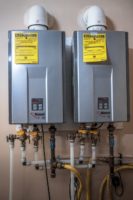
Propane tankless systems are an efficient, affordable solution for any project What is your customer’s biggest water heating concern? Running out of hot water? Rising utility costs? Environmental sustainability? Builders, remodelers, and contractors can address any of these concerns by helping customers select a high-efficiency propane tankless system. Tankless technology is becoming increasingly popular because Read more
Propane tankless systems are an efficient, affordable solution for any project
What is your customer’s biggest water heating concern? Running out of hot water? Rising utility costs? Environmental sustainability?
Builders, remodelers, and contractors can address any of these concerns by helping customers select a high-efficiency propane tankless system. Tankless technology is becoming increasingly popular because of its versatility, convenience, and efficiency in both new construction projects and as retrofits to existing systems. These systems offer reduced energy costs, a long service life, and high volumes of hot water — and propane units provide a level of performance that electric and heating oil systems just can’t match.
But there are still some common misconceptions that can keep professionals and their clients from upgrading to a tankless water heater.
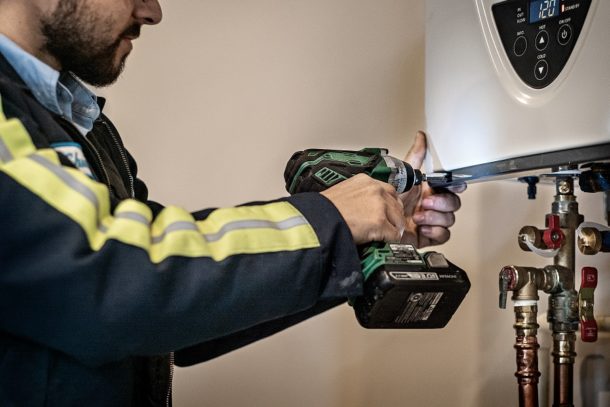
Here are four common tankless myths, debunked:
MYTH: Tankless water heaters are too expensive.
For some customers, it’s hard to look past the upfront cost of a high-efficiency tankless water heater, but it’s important to consider the system’s annual cost of ownership (ACO). Tankless water heaters reduce energy costs by up to 50 percent compared with storage tank water heaters and eliminate standby energy loss from the tank, as well as the unnecessary expense of heating water when it’s not being used — which ultimately reduces water heating bills. High-efficiency units pay for themselves in just a few short years — which is a big win for contractors and their customers. Big picture, they’re a smart investment. Plus, there are great rebates available to help bring the costs down.
In a 2015 comprehensive analysis of residential water heating systems, two propane tankless systems were found to offer the lowest ACO in eight out of nine scenarios covering different climate and housing types when compared with electric water heaters, heat pump water heaters, and heating oil systems. Propane tankless’ cost-effectiveness stems from the system’s low annual energy costs and long service life of roughly 20 years.
MYTH: Tankless water heating requires natural gas.
By incorporating propane into a project, construction professionals and contractors can give their clients the same luxury, performance, efficiency of a natural gas tankless system — no matter where the house is located. There are still a lot of builders that are building in rural areas where the natural gas line isn’t available and instead using electric tanks. They are simply not thinking of propane tankless just because it’s not as common.
What many builders and contractors may not realize is how construction-friendly this energy source is. Propane is used much like natural gas and is easy to incorporate into a project. Plus, with propane, professionals and their customers aren’t at the mercy of a public utility. Meanwhile, performance is never sacrificed. Propane tankless water heaters provide an endless supply of hot water, averaging about 222 gallons per hour, compared with an average first-hour delivery rating of just 62 gallons per hour for electric storage tank models.
MYTH: Tankless systems require complicated venting.
Venting for propane tankless systems is flexible, easy, and inexpensive. Given the unit’s compact size and direct-vent design, they can be installed in closets, tight spaces, and even outdoors. Upgrading from an electric tank to an interior propane tankless system may require a little more planning, but high-efficiency units can be vented straight through the wall with inexpensive PVC pipe.
MYTH: Tankless won’t work with well water.
Tankless is a great option for customers, whether they use city water or well water. When a water heater heats water, a small amount of scale can form on the heat exchanger, so periodic flushing is required to keep tankless water heaters functioning at their best. Homes with harder water or more usage will have more scale, but city water versus well water won’t affect this. Many modern tankless systems will notify the homeowner when they need to be flushed or can even be set up to notify a technician when maintenance is required. Regardless of the water source, a water softener can greatly reduce the scale created, allowing for much longer intervals between flushing. And maintenance is key — if properly maintained, propane tankless units last twice as long as traditional tank systems.
Don’t let customers settle when it comes to water heating performance for their home — and for many projects, this means choosing the limitless hot water delivery and efficiency of a propane tankless water heater. Visit Propane.com/Water-Heating to learn more.
 Bryan Cordill is director of residential and commercial business development for the Propane Education & Research Council. He can be reached at bryan.cordill@propane.com.
Bryan Cordill is director of residential and commercial business development for the Propane Education & Research Council. He can be reached at bryan.cordill@propane.com.

Cambridge Massachusetts has outlined a framework to be an emission neutral city by 2050. The Cambridge Net Zero Action Plan is a 25-year plan which envisions energy-efficient upgrades, renewable energy production and potentially the purchase of carbon offsets and credits. On their way to meeting this goal, the city recently unveiled the first net-zero emissions Read more
Cambridge Massachusetts has outlined a framework to be an emission neutral city by 2050. The Cambridge Net Zero Action Plan is a 25-year plan which envisions energy-efficient upgrades, renewable energy production and potentially the purchase of carbon offsets and credits.
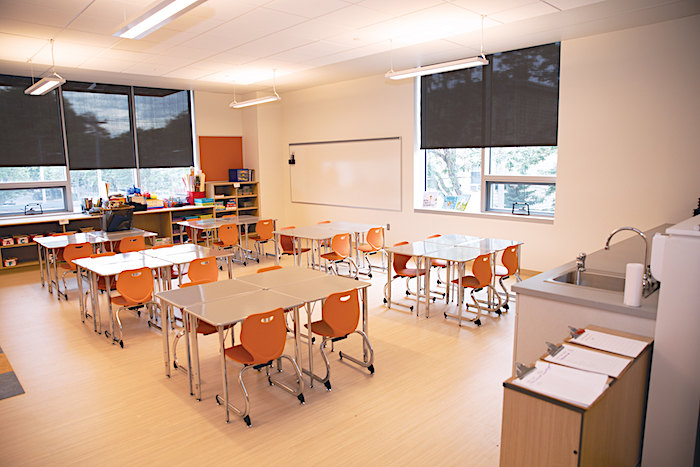
On their way to meeting this goal, the city recently unveiled the first net-zero emissions school in Massachusetts and the largest net-zero emissions building in the state: King Open and Cambridge Street Upper School campus. The campus includes an elementary school and middle school, school district offices, a public library branch, a community swimming pool, and preschool and after-school programs. The buildings are the first project under the Net-Zero Cambridge Plan and account for 273,000 sq. ft. and sit on four acres.
Eemax installed 150 LavAdvantage tankless electric water heaters, 10 Three Phase units and three SafeAdvantage units throughout the campus. Eemax products support specifications ranging from 1.8 kW to 150 kW, and flow rates from 0.2 GPM to 30 GPM. They installed the following on this campus:
- LavAdvantage: 150 units’ support handwashing in every classroom and restroom. They feature active energy management, power modulating controls, and a small, compact design also suitable for ADA compliant facilities. LavAdvantage provides safe, hot water on demand, while reducing energy and water waste.
- SafeAdvantage: 3 units provide tepid water for eye and facewash safety equipment in school laboratories. In schools, this tankless electric water heater can be found in chemistry and biology labs where an eyewash, facewash, and/or drench shower is required. SafeAdvantage features Parabolic Heat Design technology and is designed for low duty cycle applications where precise temperature control and low pressure drop are required.
- Three Phase: 10 units provide endless hot water to support janitorial services throughout the campus. Three Phase water heaters can support capabilities up to 5 GPM and deliver a temperature range from ambient to 180 degrees Fahrenheit. Each unit is thermostatically controlled, and features Self-Modulating Technology, which provides precise outlet temperatures.
“This new LEED Platinum facility and complex proves Massachusetts’ unwavering commitment to ensuring the Cambridge community will have a clean and green facility for their students as well as the neighboring families,” said Jens Bolleyer, vice president & general manager, Eemax. “We are proud to be a sponsor, as well as a solution, supporting zero emission goals and providing safe and consistent hot water with our LavAdvantage and SafeAdvantage products.”
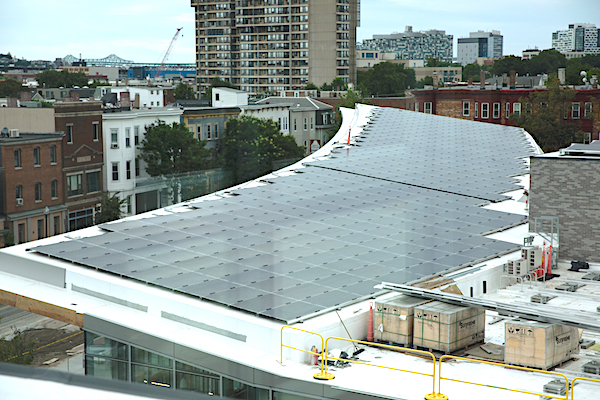
Roof-mounted PV array will generate an estimated 60% of energy on site.
Eemax tankless electric water heaters only consume energy when the water is turned on, and there is no water or energy waste waiting for hot water to reach the faucet. Another benefit of tankless electric water heating at the point-of-use is the elimination of recirculation loops and the energy waste (standby heat loss) generating 24/7 hot water that exists with traditional commercial boiler systems. In addition, as only one water line is necessary, a significant savings in material and labor can be realized during the construction phase. Tankless electric water heating is a zero-greenhouse gas emission solution. No venting is required as no fossil fuels are burned.
Project Details
- Units: This campus includes a middle school, an elementary school, a public library, and the administration offices for the school district
- Square Footage: 273,000
- Type of Construction: New
- Built for LEED v4 Schools Gold certifications
- Eemax tankless electric water heaters throughout the school and complex
- Roof-mounted PV array will generate an estimated 60% of energy on site
- Geothermal heat pump system provides radiant heating and cooling
- Rainwater reclamation system on site

